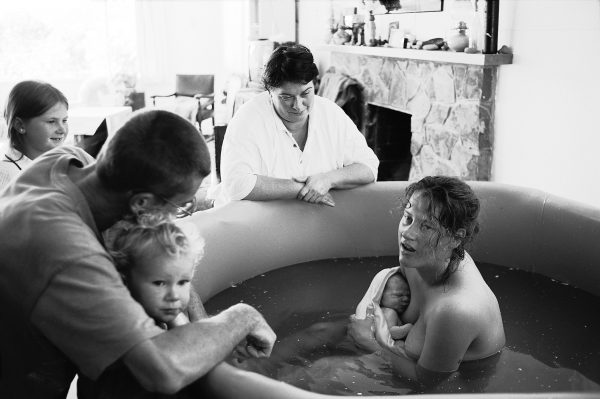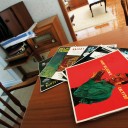
Home delivery
Travels with a Coromandel midwife


My first contact with midwife Jenny Johnston came soon after arriving on the Coromandel Peninsula in 1995. With my wife, Terri, and our two-year-old daughter, Aroha, we had set up home overlooking the township of Thames and were busy preparing for the arrival of our second child.
For Terri, the idea of having a home birth was firmly decided. I guess I went along with it because it seemed “natural” and therefore probably a good thing.
I’d already witnessed Aroha’s birth in a home environment, although that was at a midwife’s residence equipped with most of the life-saving apparatus one associates with the medical profession, and it had worked out fine.
I had listened to all the arguments for and against home birth, and had to agree that hospitals did seem the place for the sick, not fit and healthy mothers-to-be.
My own mother had trained as a midwife and made many domiciliary deliveries before settling down to raise a family of her own. Finally, I figured, whatever objections I might raise really didn’t stand up, as this was one event where a man’s role was purely as an onlooker.
Even so, when Jenny arrived at the door for our first meeting I felt a little awkward. I wasn’t so sure I wanted this stranger supervising such a personal and intimate experience as the birth of our child. Maybe it was some kind of paternal instinct that had me fearing the intrusion of another woman into our nest. But given the lack of time—Terri was well into the last trimester—the die was pretty well cast.

I gradually began to accept the fortnightly appearance of Jenny as she called to monitor progress. The frequency of her visits increased as we got nearer to the due date, which came and went with no sign of a baby.
When still nothing had happened two weeks later we were becoming more than a little anxious. I had photographic assignments out of town which I was putting off, and that was worrying me. Terri’s concern was that the baby was all right.
Jenny calmly reassured us that the delay was perfectly natural and that the baby was probably just not ready to come out yet. All good, sensible advice, I suppose, but in these days of high-tech medicine, when Caesarean sections and induced labours are commonplace, being told to relax and be patient was hard to accept.
It was then that it began to dawn on me that in Jenny we were dealing with someone with a simpler, less complicated approach to birth: one prepared to let nature run its course with as little interference as possible; one more interested in the baby’s health and well-being than fitting into the busy schedules and agendas of modern lifestyles.
I began to develop a deepening respect for our midwife. At a time when parents-to-be are at their most vulnerable, fretting over the arrival (or nonarrival) of a new baby, advice comes from all quarters. Mostly well-intentioned, such advice often only serves to confuse and heighten all those fears and uncertainties lurking in the minds of an inexperienced couple preparing for an event in their lives like no other. To have close, in-the-home support and guidance from someone with years of experience is invaluable.

Finally, Terri’s time came, and Jenny, with her colleague Michelle Fill, another home-birth midwife operating on the Coromandel Peninsula, attended the delivery. It was one of those labours that go on and on through the night, testing the stamina of everyone involved and a reminder of which truly is the weaker sex: the male!
Seeing these midwives confidently, instinctively support Terri as our child was being born made me realise that this is a woman’s domain. They seemed to anticipate when each contraction was about to begin and to offer the appropriate relief, such as towels soaked in hot water and laid across Terri’s back.
For my part, I did what I could—or, more accurately, what I was directed to do. But I was relieved not to be burdened with many of the tasks these midwives fulfilled.
And then our daughter was born, and in that brief moment when time stands still, as she made her entrance into our world, I recognised the fragility of it all and the absolute trust we had placed in our midwives to bring this miracle of life safely from the womb.
[Chapter Break]
Eighteen months later, but an entirely different outcome. I guess we’d become a little complacent by this time. We felt we had weathered the challenges of parenting quite well, and with two healthy toddlers to our credit it hadn’t seemed necessary for an ultrasound scan. So when Jenny and Michelle arrived again to perform their duties, everything seemed to be progressing normally. It was only the intensity and pain of the labour that suggested otherwise. Even then, only Terri really suspected something was wrong, as the baby’s heartbeat sounded regular and strong.
It is still difficult to describe, even many months later, that instant when our son was born, and Jenny’s words informing us that our baby would not live; the desperation we felt as we clutched at any hope that she could be wrong, and the realisation, as other professionals were called, that nothing could be done to save our child, born anencephalic, an acute form of spina bifida.

Through the blur of the following days, as we nursed our infant son until his tiny life expired, I was conscious of the support we were given by Jenny and Michelle, but it was only later that I realised exactly how much they had done for us.
Jenny remained with us during that first night and through the next, until Daniel died, cradling him in her arms for his last few hours as he struggled with breathing. Her advice, when in our grief and confusion we sought instruction on what we should do, could do, for him, was simply to “love him.”
It was during the day after his death, when Michelle arrived to help us bathe and prepare his body, encouraging us to take photographs and prints from his hands and feet as gentle reminders of his ever-so-short life (items that have become so precious to us now), that I began to appreciate the links between life and death that a midwife’s job encompasses.
[Chapter Break]
Wanting to know more about why these women choose a career that demands of them so much, yet offers so little in monetary terms, I later persuaded Jenny to allow me to accompany her on her rounds. To photograph and record something of what a domiciliary midwife’s job entails.
She agreed in principle, but told me it might not be easy to persuade her clients. For them to accept a stranger, particularly a man, wanting to photograph their birth experience might be expecting too much. I don’t think either of us held high hopes at the beginning.
Over the next few months I accompanied Jenny as she journeyed the many dusty, winding roads around the Coromandel Peninsula and Hauraki Plains, making postnatal and antenatal visits to an eclectic assortment of clients. The uniqueness of the Coromandel, for many, is its isolation. Choosing to set up home around its coastline has meant abandoning many of the conventional public services that more urban settings offer.
For some, it can be over an hour-and-ahalf’s drive to the nearest maternity annex. Those who have experienced a winter here can testify to the amount of rainfall the region receives, causing flooding and slips on most of the arterial roads. Who wouldn’t be inclined to prefer the services of a midwife at your doorstep in favour of an arduous journey with labouring partner across sometimes treacherous roads to reach a hospital bed?


For the midwives, this means the reverse. It becomes their responsibility to navigate their way to the birth. And, of course, most calls to attend a labour occur at inconvenient times. I was awakened several times to attend births when the hands of our clock pointed to the small hours of the morning. On one occasion I lingered 10 minutes too long, sorting film for my cameras, and arrived to the sound of the baby’s first cry.
I’ve never had employment that required being “on call,” so when I proposed to attend four separate births Jenny had arranged for me to photograph, I had no idea what it would involve. I had expected the sudden phone call and subsequent rush to the birth, but what I hadn’t anticipated was the sheer volume of my time that would be organised around being available.
A simple stroll to the shops could potentially delay my departure for a birth by an untimely half hour. Family excursions to places like the beach became out of the question. My relief was evident when, after two months and four babies, I had completed my photographs and felt my life was my own again. Jenny joked that, out of habit, she might continue to call me.
I often wondered how her own family had coped with the constant absences, until she confessed that her daughters had grown up particularly self-reliant, her friends often playing surrogate mother to the girls during especially long labours.
This aspect of the job was something I knew I could never become reconciled to: that aside from scheduled holidays, any spontaneous decision had to be considered against the likelihood of a possible labour. That extra glass of wine, a swim in the sea, a trip to the city. I know I don’t have the necessary attributes for this vocation—few men, I think, would—but after meeting these midwives on the Coromandel, it’s a pleasure to know people who do.
















